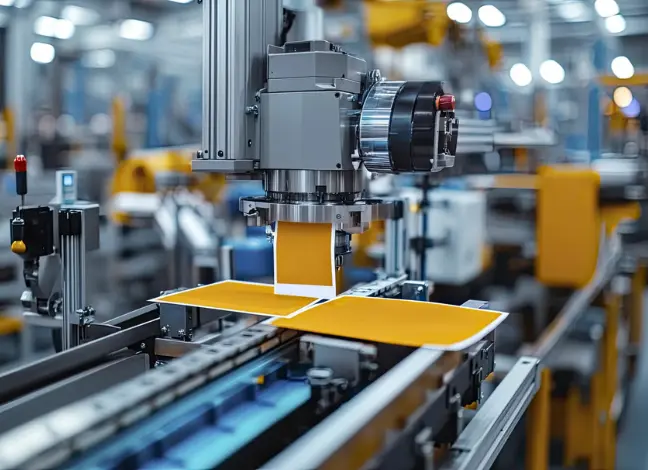Equipment labels are essential for safety, compliance, and operational efficiency in various industries, including manufacturing, healthcare, construction, and logistics. These labels provide critical information, including warnings, instructions, maintenance details, and identification codes.
Poorly designed or missing labels can lead to accidents, regulatory violations, and equipment misuse. To ensure that equipment labels serve their intended purpose, it is essential to consider several key factors.

With that said, here are a few key considerations for equipment labels:
Durability and Material Choice
Durability is one of the most critical factors in its effectiveness. Depending on the location of the equipment and its environmental conditions, labels must withstand harsh conditions, including exposure to chemicals, heat, moisture, ultraviolet light, and extreme temperatures.
Choosing the right material for your equipment labels is essential. Common materials include vinyl, polyester, and aluminium, which are known for their resistance to fading and peeling. Vinyl is often used for its flexibility and ability to adhere to various surfaces, while polyester offers greater durability and resistance to abrasion. Aluminium labels are more commonly used for industrial equipment, where rugged durability is required.
A metal nameplate is another excellent option for applications requiring maximum durability. These labels are particularly effective for heavy-duty equipment exposed to harsh industrial environments. They’re made from materials like stainless steel, aluminium, or brass, which makes them resistant to wear, scratches, and corrosion. They can also withstand high temperatures, chemical exposure, and physical impacts, making them ideal for long-term use.
The type of adhesive used is just as important as the label material. A strong adhesive ensures the label stays intact, even on surfaces exposed to vibrations, moisture, or heavy usage. If equipment is likely to be handled frequently or exposed to extreme conditions, labels with strong, industrial-grade adhesives are necessary.
Clear and Readable Information
The purpose of equipment labels is to communicate vital information. Whether it’s the manufacturer’s details, serial numbers, maintenance instructions, or safety warnings, the text must be legible at a glance. Using a readable font is essential. Fonts like Arial, Helvetica, or Times New Roman are often the best choices due to their clarity and simplicity.
The font size should be large enough to be visible from a distance but not so large that it occupies too much space on the label. A good rule of thumb is to ensure people can read the text from about 3 to 6 feet away. Additionally, the contrast between the text and background is crucial. Dark text on a light background or vice versa usually offers the best visibility.
Another crucial consideration is the placement of information. For example, safety instructions should be placed prominently, accompanied by clear warning symbols that immediately capture attention. Other details, like manufacturer information or serial numbers, can be placed in a smaller font size but remain readable.
Compliance With Regulations
The manufacturing, healthcare, and food production industries often have strict regulations governing equipment labelling. Adhering to these regulations is crucial for ensuring labels are legally compliant and deliver the necessary information to uphold safety standards.
For instance, the Occupational Safety and Health Administration (OSHA) requires specific safety labels on machinery in industrial settings to help prevent accidents. These labels must include hazard warnings, emergency contact details, and clear instructions for safe operation.
In healthcare environments, labels must meet regulatory standards for identifying medical equipment. This often includes barcodes for tracking, sterilisation dates, and usage instructions.
Before creating equipment labels, familiarise yourself with the relevant industry regulations and standards. This includes knowing the required symbols, colors, and font sizes for different label types. Staying compliant with these rules will help you avoid legal challenges, promote a safer work environment, and reduce the risk of accidents.
Barcodes and QR Codes
Barcodes and quick response (QR) codes are powerful tools for managing and tracking equipment. Barcodes provide a unique identifier for each piece of equipment, enabling inventory management systems to track items, schedule maintenance, and maintain records of equipment usage.
Operators can scan a QR code with a mobile device to access a wealth of information about the equipment, including maintenance history, user manuals, or safety instructions. This can be helpful in industries where equipment is frequently serviced and workers need to quickly access information on maintenance schedules, repair logs, or operating instructions.
However, when using barcodes or QR codes, it’s essential to place them in a location that’s easily accessible and scannable. They should be large enough to be scanned quickly and without obstruction, and the labels should be clear enough to prevent errors during scanning.
Icons and Symbols
Incorporating symbols and icons into your equipment labels can help convey critical information more effectively. Symbols provide a universal understanding, particularly in environments where team members speak different languages or work in areas with high noise levels, making it challenging to read small text.
For instance, warning symbols like the exclamation mark in a triangle can alert workers to potential hazards. You can also incorporate safety-related symbols, such as fire extinguishers, electrical warnings, or eye protection, into the label design. These visual cues are invaluable for identifying equipment that requires special attention or handling.
When using symbols, it’s crucial to ensure they’re standardized and recognized by all team members. The International Organisation for Standardisation (ISO) provides guidelines for using safety symbols that are widely recognised across various industries. Always verify that the symbols are universally understood and conform to industry standards.
Visibility and Placement
The placement of labels on equipment is just as crucial as the design. A label placed in an inconspicuous or hard-to-read spot can reduce its effectiveness. You should place labels where operators, maintenance personnel, or anyone else who needs the information can easily see and access them.
When determining a label’s placement, consider the equipment’s nature and its intended use. For example, the most critical safety labels or operational instructions on a machine should be placed on the front panel or near the controls. Labels indicating the serial number or model number can be placed in less visible areas, but they should still be accessible for quick reference.
Also, consider the frequency with which the equipment will be handled or inspected. Labels on high-touch equipment should be placed in positions that are easily accessible, while those on stationary or less frequently handled equipment can be placed in less accessible locations.

Customizable Labels
Different types of equipment require unique label designs to ensure they serve their intended purpose effectively. For instance, medical equipment labels must include regulatory compliance information and safety instructions that meet the standards of the healthcare industry.
Conversely, industrial machinery labels often require providing detailed maintenance instructions, safety warnings, and operational guidelines. Customizing labels for each type of equipment ensures that the necessary information is communicated.
Advanced technologies, such as additive manufacturing or three-dimensional (3d) printing, can further enhance label customisation. You can design labels to fit complex or irregularly shaped surfaces, providing a seamless and durable solution for specialized equipment. This enables highly customised labels that withstand harsh environments, contributing to a more organised and efficient labelling system.
Conclusion
Creating effective equipment labels isn’t just about regulatory compliance—it’s about protecting your team, maximizing operational efficiency, and extending the lifespan of your valuable assets. With the above considerations, you can ensure your labels serve as clear, reliable sources that help prevent accidents, facilitate maintenance, and streamline operations.
Remember that labels are communication tools that speak when you can’t be there to provide guidance. So, inspect and update your labels as equipment changes or regulations evolve. What might seem like a small detail today could prevent a significant incident tomorrow.
